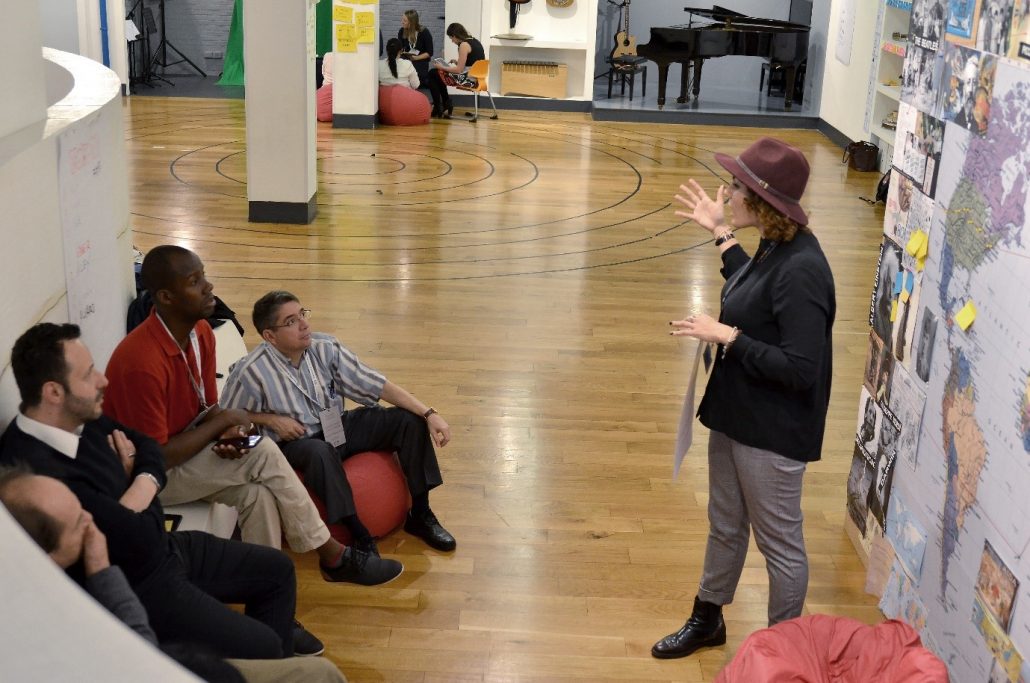Round Robin

Creating a collective perspective
Overview
The Round Robin is for rapid and intense engagement with subject matter. It is similar to a World Café, but is guided by experts. Participants address the subject matter in a series of rotations within small groups.
How to use it
- Activate past learning and build collective knowledge.
- Cross-fertilize knowledge across disciplines and connect experienced people.
- Explore issues and solve problems.
- Analyze situations and create comprehensive perspectives.
How to apply it
Start:
- Identify learning objectives and select several topics accordingly.
- Decide on topics and create corresponding working groups of participants. This works well with large groups.
- Identify 3 to 8 aspects of each topic to discuss. These could be management, participation, scope and sustainability of a project, for example. Each aspect does not necessarily represent a round. However, it will provide a framework for the working process.
Setting:
- Set up separate working spaces that are close enough together for quick transitions of people, yet far enough apart not to create a lot of noise interference.
- Each space should be equipped with a writing wall or flip-charts, writing utensils and a semi-circle of chairs. Divide the writing wall into columns for each aspect under consideration, or set up one flip-chart for each aspect. If using flip-charts, write the aspect on a flash-card so that it can be moved to new pages as they are filled up and turned over.
Time/Steps:
- Allow 1.5 to 2 hours for the entire session, or 20 minutes per topic.
- Assign an expert to each topic. They may be selected from the group or recruited externally in advance.
- 5 to 10 minutes: The expert introduces the topic.
- Approx. 15 minutes: The group engages in a discussion of the aspects of the topic.
- Play a sound or announce the end of the round and instruct participants to move to the next area.
- Timeframes must be strictly enforced to ensure that all participants tackle each issue.
- Each rotation should build upon the work of the previous group, rather than repeat points. This requires that the expert be well briefed in advance on how to present and summarize after each rotation.
- Incoming participants then add, complement, correct, specify and exemplify what has already been written.
- Instruct the final rotation to reflect on the priority points and key reflections of all rounds.
- Have participants pull their chairs out to create one large circle, including the flip-charts with final reflections. If writing walls were used, situate them just outside the circle of chairs.
- Allow no more than 3 minutes for each report back. This will force the expert to summarize the collective insights.
- Capture the outcomes by whatever means available and be sure to communicate them in the end-of-activity report, or using Web 2.0 tools such as Discussion Forums UPDATE or Podcasts.
How to adapt it
- Participants may be allowed one additional rotation to return to their original groups and review the final product or collection of knowledge that accumulated on top of their initial contributions.
- Rather than creating a large circle of chairs for the debriefing, try moving the entire group from one working space to another. This may take slightly longer and its feasibility will depend on the group size and room lay-out.
Case study
Title:
Experimental learning with a Round Robin
Activity:
Inter-agency conference
Contact:
Monica Lisa, M.Lisa@itcilo.org (DELTA)
Description:
The Round Robin was selected to allow 120 participants to interact with the subject matter and experts. The group was divided into two, and then again into 3 groups of approximately 20 to examine the issues. Each round lasted 15 to 20 minutes. The rounds investigated four leading questions and were accompanied by visual displays to reach different types of learners.
After input from the group’s expert, the thinking and analysis processes were made interactive by constructing models and creating diagrams that visualized the challenges of each case. Each successful round accumulated a more complex and comprehensive understanding of the cases. The experts themselves remained on hand during other sessions of the activity itself. This continued the learning process and helped to establish more direct working relationships. The activity was so well received that one of the experts wrote a 5-page report on the Round Robin method for others in her field.
Tips
- The time allowed for each round of discussion can be gradually cut as they progress. As information is accumulated, each group will have less to contribute.
- To avoid frustration or people becoming flustered by the rapid pace, create a playful atmosphereby, for example, playing silly sounds to indicate when it is time to rotate.
- Provide time warnings in the last two minutes of each round.
- Use a microphone to announce rotations, to be loud and clear about everyone having to move immediately.
- Note when ideas and concepts spill across several issues, and comment on this during the debriefing.
- Do not hold one on the first day of an activity, or at the end of any day. It requires participants to be comfortable with participatory learning and clear about working this way. Furthermore, it is an intense exercise which requires a lot of energy and attention to work well.





